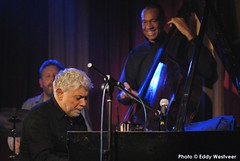Retrospect
 On the last day of the year most people look back to the past year. So do I !!. A year with a lot of inspired moments will be part of the memory tomorrow.
On the last day of the year most people look back to the past year. So do I !!. A year with a lot of inspired moments will be part of the memory tomorrow. Let's remember some remarkable moments. Well, of course the invasion of the Vikings this summer. It was great to have our Danish friends around and to show them our beautiful province of Zeeland ( southwest part of the Netherlands). The small reunion of the so-called Alemaniacs was a great moment, remembering our trip to the Convention of the IAJRC (International Association of Jazz Record Collectors) in Copenhagen (Denmark) the year before.
 If you have a look at my concert blog you'll learn that I was able to visit a lot of inspired concerts. It is not so difficult to tell what concert was most impressive: The Alexander-Clayton-Hamilton Trio. These three skilled musicians were the highlight of the year.
If you have a look at my concert blog you'll learn that I was able to visit a lot of inspired concerts. It is not so difficult to tell what concert was most impressive: The Alexander-Clayton-Hamilton Trio. These three skilled musicians were the highlight of the year. >
 Other concerts shouldn't be unmentioned: the reconstruction of the Chet Baker Quartet by Fay Claassen ( scat singing Chet's part on the trumpet); James Spaulding ( a skilled and also very nice musician );
Other concerts shouldn't be unmentioned: the reconstruction of the Chet Baker Quartet by Fay Claassen ( scat singing Chet's part on the trumpet); James Spaulding ( a skilled and also very nice musician ); James Carter ( I saw him twice in concert - he turned out to be a great musician the second time ); good old Benny Golson ( ........ and my name is Johnny Griffin .....) with some veteran players like Al Foster and Buster Williams and, not to forget, Gary Smulyan and Jan Menu in their baritone battle a few weeks ago.

I was very happy to learn that Roy Hargrove returned to his roots, next to his RH Factory and recorded a great hardbop album. His concert at the North Sea Jazz Festival in Rotterdam last July was great.
Randal Corsen is a piano player that surprised me - It's good to know that he will perform in two more concerts at Porgy en Bess Jazz Club in Terneuzen (southwest part of the Netherlands) next year.
Thanks to all volunteers in Porgy en Bess in Terneuzen last year great names in jazz came to our remote region. In April 2007 the club will celebrate its 50th birthday.
 In February of last year I started my daily Keep swinging web log, just for fun, as a place where I could share my passion to jazz and record collecting. Thanks to Joergen ( Thanks Jo) this blog could be released at a daily scedule for more then 300 times now and reaches an average of nearly ninety visitors a day now.
In February of last year I started my daily Keep swinging web log, just for fun, as a place where I could share my passion to jazz and record collecting. Thanks to Joergen ( Thanks Jo) this blog could be released at a daily scedule for more then 300 times now and reaches an average of nearly ninety visitors a day now. The artist on record that should be number one in my Top 2000 is, I guess, Jacob do Bandolim. Thanks to Joergen, who feeded me with Choro recordings last year and introduced me to this kind of stuff, I learned to appreciate Choro music.
To wind up this retrospective of the year I love to share a rather moderate film fragment of Epoca de Oura, but with some very good music of Jacob do Bandolim - Noites Cariocas.
Keep swinging
Hans Koert
Nederlands ( To the English translation )
Op de laats
 te dag van het jaar kijkt men terug op het bijna afgelopen jaar. Dat doe ik dus ook maar. Een jaar waarin een heleboel inspirerende momenten voorkwamen -morgen is het allemaal herinnering.
te dag van het jaar kijkt men terug op het bijna afgelopen jaar. Dat doe ik dus ook maar. Een jaar waarin een heleboel inspirerende momenten voorkwamen -morgen is het allemaal herinnering. 
 James Carter, die ik twee keer hoorde spelen, maakte zijn reputatie tijdens het tweede concert helemaal waar en het was goed om good old Benny Golson ( ......and my name is Johnny Griffin .....) weer eens te zien met veteranen als Al Foster en Buster Williams. Uiteraard blijft het baritonesax-gevecht van Gary Smulyan en Jan Menu van een paar weken geleden boven drijven.
James Carter, die ik twee keer hoorde spelen, maakte zijn reputatie tijdens het tweede concert helemaal waar en het was goed om good old Benny Golson ( ......and my name is Johnny Griffin .....) weer eens te zien met veteranen als Al Foster en Buster Williams. Uiteraard blijft het baritonesax-gevecht van Gary Smulyan en Jan Menu van een paar weken geleden boven drijven.  en zou kunnen neerleggen. Dankzij Joergen ( Bedankt Jo) kon deze weblog al meer dan driehonderd keer dagelijks verschijnen en gezien de reacties van de gemiddeld bijna negentig bezoekers per dag, wil ik voorlopig nog even doorgaan. Mijn inspiratie is nog niet opgedroogd.
en zou kunnen neerleggen. Dankzij Joergen ( Bedankt Jo) kon deze weblog al meer dan driehonderd keer dagelijks verschijnen en gezien de reacties van de gemiddeld bijna negentig bezoekers per dag, wil ik voorlopig nog even doorgaan. Mijn inspiratie is nog niet opgedroogd. Om deze terugblik af te ronden heb ik nog een filmpje gevonden van de band Epoca de Oura. De beeldkwaliteit is slecht, maar de muziek des te mooier. Ze spelen een nummer van Jacob do Bandolim Noites Cariocas.
Keep swinging
Hans Koert

























